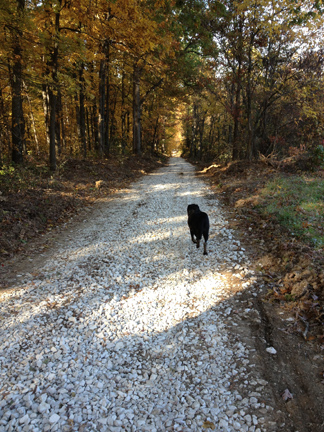Getting Stoned
By Mike Warner
Now that I have your attention let’s discuss the ABC’s of using stone or rock or gravel or aggregate, or whatever you choose to call it, in your forestry operations. For the purposes of this article let’s refer to it as “stone” since that is what got your attention and got you to this point.
Although it is an added expense, stone is a valuable material on almost every logging job. Stone provides all-weather access to trucks, protects stream crossings, and provides erosion control for critical areas on your forest property. When used properly stone will pay for itself by increasing productivity and by providing access to your timber resource. Land owners who plan for and provide good access to their timber can certainly expect more interest and higher returns from timber buyers at sale time.
Where to use Stone?
Stone is referenced in nearly every one of the Indiana Logging and Forestry Best Management Practices. Highway entrances are a common place stone is used on logging projects. The idea is to prevent mud from getting on the highway which is both a sediment and safety concern. It is also a good way to avoid those nasty looks from highway travelers, and the tickets from the highway patrol you get when they have just driven through the muck you left on the road. Ideally, at least a couple hundred feet of road should be stoned at highway entrances to allow truck tires to clean off and drop their loads of dirt and mud before reaching the highway. This “cleaning” is also helpful in reducing the spread of invasive species.
In some cases it may be necessary to stone the entire road from the highway to the landing area. If you need to use the road in all weather conditions, stone will keep the road more passable and help prevent sediment problems that will occur with heavy use during wet weather.
Stone is effective in stabilizing the soft road and trail approaches to stream crossings. These areas can contribute large amounts of sediment if they are not reinforced with stone. Whenever possible it is best to excavate some of the soil from these approaches before placing the stone. This helps hold the stone in place allowing it to do its job more effectively. Stone is also useful at culvert inlets and outlets to protect critical areas and to act as an energy dissipater, reducing sediment delivery to water courses.
What Type of Stone?
Three types of stone are most commonly used in the applications discussed above. Number 2 limestone is a fist-sized stone mostly used as the base for logging roads and truck pads at landing areas. This mid-sized stone bonds well with the soil and has the strength necessary to support heavy logging equipment. Rip-rap is a larger stone with mixed sizes ranging from 4” to 14” in diameter. It is most useful at road and trail approaches to stream crossings and around culvert inlets and outlets. The larger size and weight is needed where water velocities would wash a smaller stone away. The third stone is smaller and is the number 53 limestone. It typically contains stone that is no larger than one inch in size and often has a percentage of fines (ground up limestone). This stone is mostly used to top off the larger stone placed beneath it. This smaller stone and fines help bond the stone together, reduces water penetration and provides a smoother travel surface.
In most cases 4”to 6” of stone is needed to support logging trucks for any length of time. This assumes a solid soil foundation underneath. Anything less is “window dressing”. Rather than economizing on the depth of stone, consider placing plenty of stone where it is needed most and skipping other less critical areas.
Disappearing Stone?
Most loggers have stories about disappearing stone. Unstable soils usually associated with unpacked fill material and poorly drained soils can become bottomless pits and swallow all of the stone you place there. These unstable areas are commonly found around newly installed culverts and at stream crossings.
Possible solutions to this problem include adequately packing the fill as it is placed and provide water drainage away from the site to prevent saturation of the fill. In an ideal world the road should be allowed to “settle” for a year before it is used for logging.
Another way to avoid losing stone in “soft spots” is to place geo-textile fabric under your stone. This fabric provides 3 functions: SEPARATION of the stone from the soil beneath, FILTRATION which allows excess water to pass from the stone layers to the soil below, and REINFORCEMENT by supporting the tensile forces that cannot be carried by the stone or soil. At a cost of $1.00 per square yard the fabric will pay for itself many times over by reducing the amount of stone needed in these soft areas.
Buy Good Stone!
Your first inclination might be to source your stone from the cheapest place available. Remember the adage “you get what you pay for.” The stone from reputable stone quarries is graded to provide the appropriate mix of stone sizes that will maximize the effectiveness for its use. Getting stone from that old gravel pit down the road just might be your introduction to a new invasive species too.
Stone Summary!
I am certain there is a lot more to know about stone and its applications. I am also certain that by putting the right type of stone in the right place in the right quantity landowners, loggers, and foresters can use it to effectively to protect water quality, be more productive, and be more profitable.
Mike Warner is a consulting forester with ArborTerra Consulting, Inc. and is a member of the Association of Consulting Foresters. This article is part of a series of forestry “tips of the trade” and is a service of the Indiana Association of Consultant Foresters.
